★★
“Largely unable to get out the vote.”
 There’s a fascinating story to be told about the struggle by American women to get the vote. Unfortunately, this isn’t it. Rather than being content to tell the story of the battle and those who fought in it, von Garnier (a German director who gave us Bandits) seems to want to force these women from the 1910’s into modern feminist configurations. This position is set out particularly clearly in a deliberately anachronistic soundtrack, which at times makes the story feel more like Hamilton. And to be clear, that’s not a good thing. The focus is campaigner Alice Paul (Swank), beginning in 1912 when she returns from England, her passions set on fire by the work there of Emmeline Pankhurst, as documented in the rather better Suffragette.
There’s a fascinating story to be told about the struggle by American women to get the vote. Unfortunately, this isn’t it. Rather than being content to tell the story of the battle and those who fought in it, von Garnier (a German director who gave us Bandits) seems to want to force these women from the 1910’s into modern feminist configurations. This position is set out particularly clearly in a deliberately anachronistic soundtrack, which at times makes the story feel more like Hamilton. And to be clear, that’s not a good thing. The focus is campaigner Alice Paul (Swank), beginning in 1912 when she returns from England, her passions set on fire by the work there of Emmeline Pankhurst, as documented in the rather better Suffragette.
Alice initially seeks to work with the leading American group, the National American Woman’s Suffrage Association, led by Carrie Chapman Catt (Huston), only to find their methods not radical enough for her tastes. This eventually causes her to form her own group, and begin protesting against President Woodrow Wilson, including a daily picket of the White House. Matters come to a head after the United States enters World War I, with such protests being seen as unpatriotic. This leads to Paul and other women being arrested on dubious charges, and after beginning a hunger strike in protest, the women are force-fed. Eventually, Wilson is convinced to support their cause, with the 19th Amendment, giving women the right to vote, being passed in 1920.
My main problem is that Paul never feels an authentic character. She comes over more like a 21st century woman transplanted to the time, which as result, makes her story feel almost like a bad episode from the current incarnation of Doctor Who. It chooses to manipulate history purely for dramatic purposes, such as shoehorning in a romantic relationship with a newspaper cartoonist. Yet for all the obviously liberal credentials inherent in the story, according to the film, only one black woman supported the suffrage movement – and just for a minute or two, before exiting the film. Awkward, that.
Despite the above, and the film in general being a stylistic mess, you’d have to try particularly hard to screw up the underlying story, which is generally an empowering and rousing one. You’d have to be a colder heart than I, not to feel aggrieved by the treatment Paul and the other women suffer in pursuit of their cause, and the film does manage to do these elements justice, simply by reining back in the attempts to jazz things up. I was amused (and slightly pleased) by the disdain of NAWSA towards their bomb-flinging sisters across the Atlantic, who were rather keener on direct action. Though the main moment which amazed me was the scene where President Wilson walked out of the front gate of the White House, tipping his hat to the protestors as he passed them. Truly a different era.
Dir: Katja von Garnier
Star: Hilary Swank, Frances O’Connor, Julia Ormond, Anjelica Huston





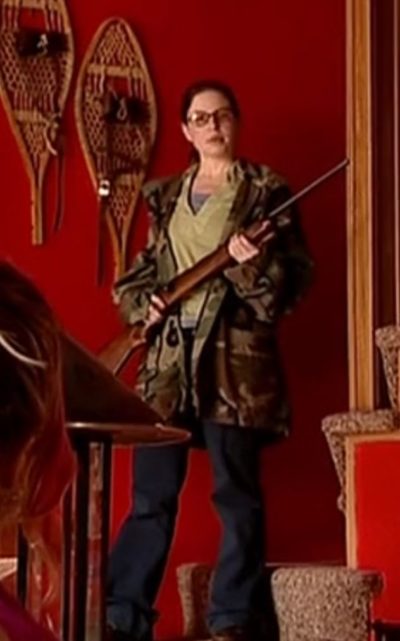



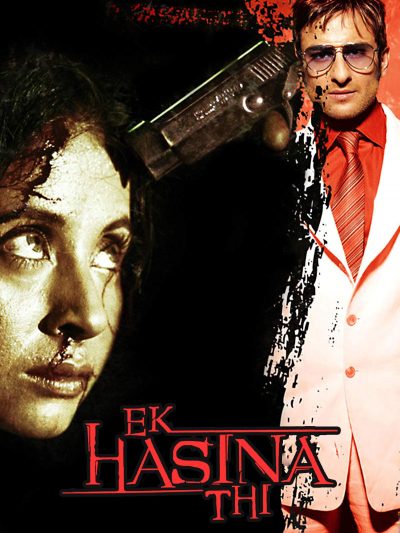 A somewhat cheesy melodrama, this throws together elements from Western pot-boilers Double Jeopardy and If Tomorrow Comes, adds a handful of Bollywood spice, and to be honest, probably overcooks the whole thing a bit. The title translates as “There Was a Beautiful Woman”, presumably referring to the heroine of the piece, travel agent Sarika (Matondkar). Into her office one day comes hunky businessman Karan Singh Rathod (Khan), and after some reluctance, she begins a relationship with him. However, it turns out he is actually a mobster, and manipulates her into taking a fall rather than incriminating him, which nets Sarika a seven-year prison sentence. Escaping from jail, she vows to destroy her former lover, and in turn, works on framing Karan with his criminal pals, by making it look like he murdered a colleague and stole money.
A somewhat cheesy melodrama, this throws together elements from Western pot-boilers Double Jeopardy and If Tomorrow Comes, adds a handful of Bollywood spice, and to be honest, probably overcooks the whole thing a bit. The title translates as “There Was a Beautiful Woman”, presumably referring to the heroine of the piece, travel agent Sarika (Matondkar). Into her office one day comes hunky businessman Karan Singh Rathod (Khan), and after some reluctance, she begins a relationship with him. However, it turns out he is actually a mobster, and manipulates her into taking a fall rather than incriminating him, which nets Sarika a seven-year prison sentence. Escaping from jail, she vows to destroy her former lover, and in turn, works on framing Karan with his criminal pals, by making it look like he murdered a colleague and stole money.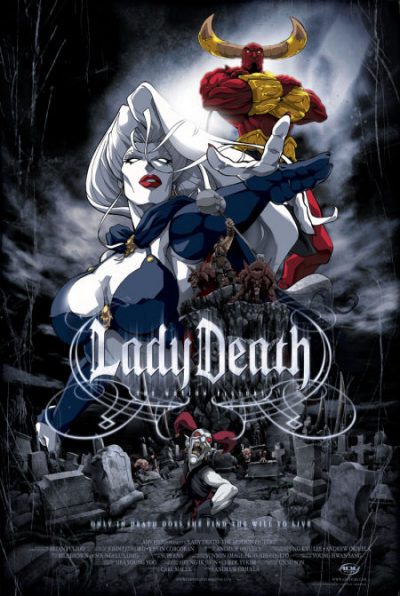 My first viewing of this was on a day off from work, when I was down with some sinusy thing, and dosed up on DayQuil. So I chalked my losing interest and drifting off to the meds, and once I felt better, decided this deserved the chance of a re-view. However, the result was still the same: even as a bright-eyed and bushy-tailed viewer, I found attention lapsing. For this animated version of a mature comic, might as well be a He-Man and the Masters of the Universe episode. Which is a shame. I wanted to like it, since the creator of Lady Death, Brian Pulido, is something of a local comics legend here in my adopted home state of Arizona. This should have been better.
My first viewing of this was on a day off from work, when I was down with some sinusy thing, and dosed up on DayQuil. So I chalked my losing interest and drifting off to the meds, and once I felt better, decided this deserved the chance of a re-view. However, the result was still the same: even as a bright-eyed and bushy-tailed viewer, I found attention lapsing. For this animated version of a mature comic, might as well be a He-Man and the Masters of the Universe episode. Which is a shame. I wanted to like it, since the creator of Lady Death, Brian Pulido, is something of a local comics legend here in my adopted home state of Arizona. This should have been better. This is largely included purely for completeness: if this had been a stand-alone film, it likely wouldn’t have qualified, not reaching the mandatory minimum quota of action heroineness. For in this sequel, Major Kusanagi (Tanaka) has abandoned even her artificial physical form, for life entirely inside the Internet. Her presence in this is therefore more spiritual, with Batou (Yamadera) referring to her as his “guardian angel”, and her impact is more felt than seen – particularly in its ramification for Batou, whose degree of cybernetic enhancement is not much lower than hers. She only returns to a tangible persona in the final scene, where Batou has to take on a near-endless stream of combat-reprogrammed sex robots. My, that’s a phrase I never thought I’d be writing…
This is largely included purely for completeness: if this had been a stand-alone film, it likely wouldn’t have qualified, not reaching the mandatory minimum quota of action heroineness. For in this sequel, Major Kusanagi (Tanaka) has abandoned even her artificial physical form, for life entirely inside the Internet. Her presence in this is therefore more spiritual, with Batou (Yamadera) referring to her as his “guardian angel”, and her impact is more felt than seen – particularly in its ramification for Batou, whose degree of cybernetic enhancement is not much lower than hers. She only returns to a tangible persona in the final scene, where Batou has to take on a near-endless stream of combat-reprogrammed sex robots. My, that’s a phrase I never thought I’d be writing… ★★★★½
★★★★½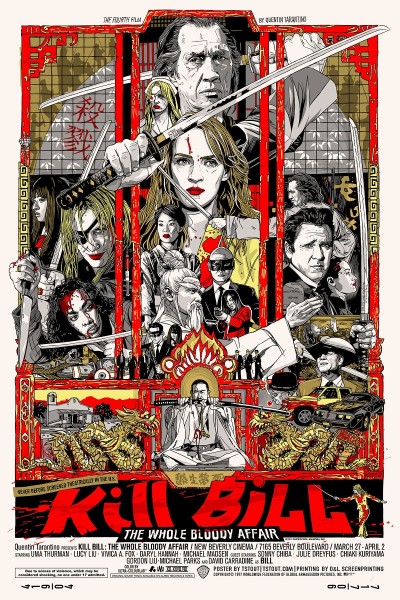 In terms of content, there isn’t much alteration, with the only real change, a small but significant cut at the end of Volume 1. What’s removed, is Bill’s line, “Is she aware her daughter is still alive?” This means neither audience nor heroine know this, until she shows up at Bill’s house for the final confrontation. [I have to say, her daughter certainly doesn’t seem like a four-year old either.] Rather than substance, the biggest difference for me was stylistic: the overall balance seemed more even, as a single entity, than seen as two separate pieces months apart. Volume 2 seemed excessively talky on its own. While that’s still the case, it’s to a significantly lesser degree, being balanced directly by the first half, where The Bride engages in actions, not words. Indeed, the only person she kills in the second part is Bill, a sharp contrast to the pile of corpses left in her wake during its predecessor. His death still feels somewhat rushed, and it’s a shame the original ending – a swordfight between Bill and Beatrix, clad in her wedding dress, on the beach – couldn’t be filmed, because the production went over time.
In terms of content, there isn’t much alteration, with the only real change, a small but significant cut at the end of Volume 1. What’s removed, is Bill’s line, “Is she aware her daughter is still alive?” This means neither audience nor heroine know this, until she shows up at Bill’s house for the final confrontation. [I have to say, her daughter certainly doesn’t seem like a four-year old either.] Rather than substance, the biggest difference for me was stylistic: the overall balance seemed more even, as a single entity, than seen as two separate pieces months apart. Volume 2 seemed excessively talky on its own. While that’s still the case, it’s to a significantly lesser degree, being balanced directly by the first half, where The Bride engages in actions, not words. Indeed, the only person she kills in the second part is Bill, a sharp contrast to the pile of corpses left in her wake during its predecessor. His death still feels somewhat rushed, and it’s a shame the original ending – a swordfight between Bill and Beatrix, clad in her wedding dress, on the beach – couldn’t be filmed, because the production went over time.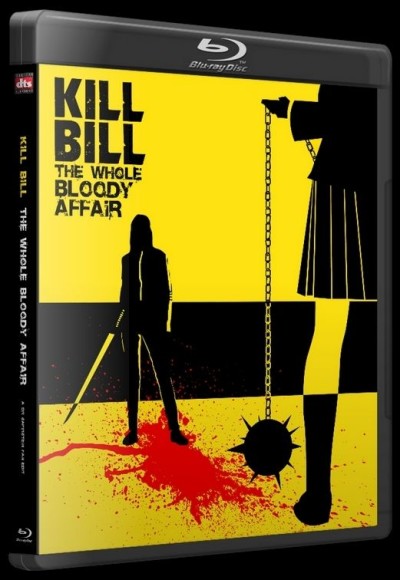 What hasn’t changed is the sheer, unadulterated awesomeness of the fights, as jaw-droppingly brutal and intense as they were ten years ago. Yuen Wo-Ping certainly cements his position as the most inventive and effective martial arts choreographer in history. Though this version has the entire House of Blue Leaves fight in colour, the arterial spray becomes
What hasn’t changed is the sheer, unadulterated awesomeness of the fights, as jaw-droppingly brutal and intense as they were ten years ago. Yuen Wo-Ping certainly cements his position as the most inventive and effective martial arts choreographer in history. Though this version has the entire House of Blue Leaves fight in colour, the arterial spray becomes 

































 Great concept: Lilith, Adam’s first wife, condemned to immortality, is now an amnesiac in a minimum-wage job. But when a demon threatens to unleash a plague of biblical proportions on the Earth, she has to be shown her true nature and convinced to hunt down the enemy. Unfortunately, almost every aspect, from exposition through characters to the action and CGI-heavy effects, are awful. Not just bad:
Great concept: Lilith, Adam’s first wife, condemned to immortality, is now an amnesiac in a minimum-wage job. But when a demon threatens to unleash a plague of biblical proportions on the Earth, she has to be shown her true nature and convinced to hunt down the enemy. Unfortunately, almost every aspect, from exposition through characters to the action and CGI-heavy effects, are awful. Not just bad:  I could hear Chris’s eyes rolling when the title came up – I can’t blame her, as the viewing immediately followed Virgin Commandos, whose mere name sent her scurrying off to Facebook poker. This, however, was not the soft-porn flick she anticipated. Instead, it’s a comedy, somewhat spoofing Gladiator, but its closest cousin is likely Carry On Cleo. That said, it’s undeniably gynocentric, with the three heroines about the only competent characters on either side.
I could hear Chris’s eyes rolling when the title came up – I can’t blame her, as the viewing immediately followed Virgin Commandos, whose mere name sent her scurrying off to Facebook poker. This, however, was not the soft-porn flick she anticipated. Instead, it’s a comedy, somewhat spoofing Gladiator, but its closest cousin is likely Carry On Cleo. That said, it’s undeniably gynocentric, with the three heroines about the only competent characters on either side.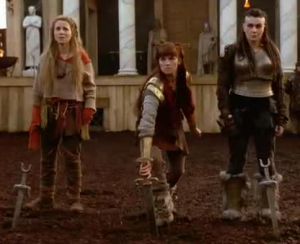 The action is undeniably limited, being played more for laughs than excitement – the much-fabled ‘Celtic Kick’, turns out to be not quite what you think. Of course, this being British humour, there are also fart and willie jokes, but works because the characters have foibles and quirks to render them human. Smirgut has lost her inner warrior since motherhood; Dwyfuc is thoroughly unimpressed by the men available to her, and Worthaboutapig has long-standing self-esteem issues – unsurprisingly, really, given her name. The results are heroines who are likeable, as well as being brave and resourceful. I found the results very refreshing, with better-drawn characters than many bigger budget movies. That was definitely
The action is undeniably limited, being played more for laughs than excitement – the much-fabled ‘Celtic Kick’, turns out to be not quite what you think. Of course, this being British humour, there are also fart and willie jokes, but works because the characters have foibles and quirks to render them human. Smirgut has lost her inner warrior since motherhood; Dwyfuc is thoroughly unimpressed by the men available to her, and Worthaboutapig has long-standing self-esteem issues – unsurprisingly, really, given her name. The results are heroines who are likeable, as well as being brave and resourceful. I found the results very refreshing, with better-drawn characters than many bigger budget movies. That was definitely